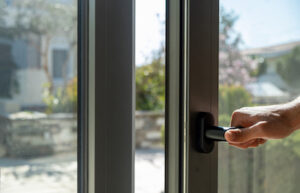Aluminum Windows and Energy-Efficiency
Aluminum windows have become increasingly popular among homeowners and architects due to their sleek design and durability. However, one common concern that arises with aluminum windows is their energy efficiency. So, are aluminum windows energy efficient?
Overall, the energy efficiency of aluminum windows depends on several factors, including the presence of thermal breaks, the type of glazing used, and any coatings applied to the glass. This is found in more modern aluminum windows so make sure to consider these factors when selecting aluminum windows for your home.
So, while we work to create a cleaner, greener building setting, we must incorporate energy-efficient technologies into our building initiatives. This is especially true when it involves windows, frequently cited as a significant source of heat transmission and structure loss. Although windows made of aluminum are energy-efficient, what makes them so? In this article, we will further explore the question of whether aluminum windows are energy efficient and discuss some important factors that impact their efficiency.

Thermal Breaks
Thermal breaks are a significant improvement over older aluminum windows that lacked this feature. As manufacturers now use thermal breaks, which are strips of insulating material within the frame, to help reduce the transfer of heat through the window. Thermal breaks help to prevent the cold metal frame from conducting heat out of the home during winter and into the home during summer. As a result, modern aluminum windows can have U-factors that are comparable to those of other window materials.
The use of thermal breaks is essential for aluminum windows to be energy-efficient. generally, they are partitions between the inner and outside portions of a frame composed of insulation polymers such as polyamide. As a result, the thermal breaks efficiently minimize the thermal bridge by reducing heat flow throughout the two components.
U-Factor
The energy efficiency of windows is determined by their ability to retain heat during winter and prevent heat from entering during summer. This is commonly referred to as the U-factor and Solar Heat Gain Coefficient (SHGC) of the window. The U-factor measures how well the window insulates and retains heat, while the SHGC measures the amount of solar radiation that enters through the window. The capacity of a substance to transmit heat is determined by its U-factor. The standard unit of measurement is watts per square meter Kelvin (W/m2K). The insulating capabilities of the material improve with decreasing U-factor.
While aluminum windows are known for their high U-factor, aluminum windows have come a long way in terms of energy efficiency in recent years. As of now window frames made from aluminum are comparatively low in heat conductivity with a U-factor of about 1.8 W/m2K. Therefore these windows have improved and are now very good at preventing loss of warmth in the winter and recovery in the summertime. As a consequence, homeowners may heat or cool their houses using less energy, which lowers their utility costs.
Double Glazing
Another factor that affects the energy efficiency of aluminum windows is the type of glazing used. Double-paned windows, which have two layers of glass separated by a layer of insulating gas, are more energy efficient than single-paned windows. The insulating gas helps to prevent heat transfer, reducing the U-factor and improving the window’s overall energy efficiency.
The capacity of windows constructed of aluminum to support two or three layers of glazing is another aspect that contributes to their energy efficiency. Typically, a layer of gas, often argon or krypton, is used to divide two panes of windows in double glazing. On the other side, triple glazing uses 3 panes of glass divided by two distinct layers of gas.
Yet somehow the insulating capabilities of the window are enhanced by double and triple glass, substantially lowering heat absorption or loss. In both scenarios a Low-emissivity (Low-E) glass is used to reflect light into the space, further increasing the windows’ energy efficiency.

Coatings
In addition to the type of glazing used, coatings can also impact the energy efficiency of aluminum windows. Low-E (low-emissivity) coatings are a popular option for improving window efficiency. These coatings reflect heat back into the room during winter and prevent heat from entering during summer, reducing the U-factor and SHGC.
Low-E glass coatings can be applied to either the outside or inside of the glass, depending on the climate and the orientation of the window. In colder climates, the coating should be applied to the inside of the glass to reflect heat back into the room. In warmer climates, the coating should be applied to the outside of the glass to prevent heat from entering the home.
Customization Options
Aluminum windows may be made to fit a homeowner’s tastes and the home’s exterior layout because they are available in a variety of forms, sizes, or patterns. As a result, homeowners may choose varied glass kinds, finishes, and gas fillings to increase the panes’ insulating qualities, which additionally contributes to their thermal efficiency. For instance, to enhance their energy efficiency, households in colder locations could choose triple glazing or low-emissivity treatments.
Recyclability
Aluminum is a highly reusable substance that only needs 5% of the energy that is required to make new metal to be recycled. As a result, aluminum windows may be recycled and used for new purposes at the end of their useful lives, minimizing waste and maximizing energy efficiency. Aluminum is a green and environmentally friendly alternative for homes that emphasize sustainability since the recycling procedure does not degrade its quality.

What to Look For In Energy-Efficient Aluminum Windows
So, if you are looking for energy-efficient aluminum windows, make sure to select aluminum frames with an insulating layer that considerably lowers heat loss by using great performance metal, double-glazed windows, warmed edge spacers, low-E glass, waterproof seals, and thermal cracking technologies. As this reduces the energy needed to maintain a specific temperature while saving households money on their heating and cooling expenses.
Benefits of Aluminum Windows
Aluminum windows offer several benefits over other window materials.
First, they are durable and require little maintenance, making them a cost-effective option over time.
Second, aluminum is a lightweight material, which makes it easier to install and handle during the construction process.
Third, aluminum windows come in a variety of styles and finishes, making them a versatile choice for any design aesthetic.
Fourth, modern aluminum windows are energy efficient, with thermal breaks, double- or triple-paned glazing, and low-E coatings all helping to improve their energy efficiency.
While aluminum windows may not have been the most energy-efficient option in the past, modern advances have made them a viable choice for homeowners and architects who prioritize sustainability and energy efficiency. Overall, aluminum windows are a great choice for those seeking durability, versatility, and energy efficiency in their windows.
In Conclusion
In conclusion, aluminum windows can be energy efficient when the right materials and design features are incorporated. Thermal breaks, double- or triple-paned glazing, and low-E coatings can all help to improve the energy efficiency of aluminum windows. When combined with other sustainable building practices, such as proper insulation and ventilation, aluminum windows can contribute to a more sustainable and energy-efficient home. Ultimately, the decision to use aluminum windows should be based on a combination of factors, including the climate, building design, and personal preferences. Homeowners and architects should carefully consider the trade-offs between different window materials and features to select the best option for their specific needs and priorities.
